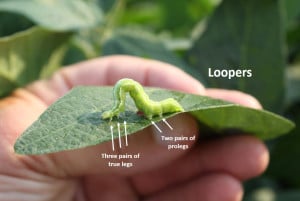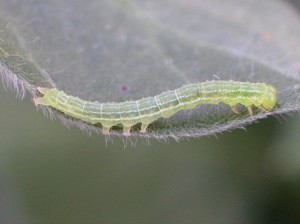Calls on soybean insect infestations are not common, and most folks are reporting less than average infestations of stink bugs. However, green cloverworms are being reported in some fields at or near economic treatment thresholds. Treatment is recommended when defoliation exceeds 20-25% from R1 to R6. Alternatively, treatment is recommended if green cloverworm numbers exceed an average of 38 larvae per 25 sweeps or if loopers number more than 19 larvae per 25 sweeps. Typically, it is suggested to ignore small larvae in these counts because predators and diseases often take a substantial toll on their survival.
It’s important to know the difference between loopers, which may include soybean loopers, and green cloverworms. Soybean loopers are much more difficult to control, whereas green cloverworms are easy to control with pyrethroid insecticides (among others). Both may move in a looping motion, but cloverworms will have three pair of prolegs and loopers will have two pair (see images below). Please refer to UT’s Insect Control Recommendations for Field Crops for suggested insecticide options.
Soybean loopers infestation are on the rise to our South, which might indicate that our late-maturing fields are at risk down the road. Fields treated indiscriminately with a pyrethroid insecticides are more likley to get infestations of soybean loopers. This is one reason I discourage automatically including a pyrethroid insecticide with fungicide applications. I know, I know, I know … it’s cheap, you’ve always done it, you’ll never have to spray again because it must last forever, yada, yada, yada. Almost all the data clearly shows that R3 insecticide applications in soybean have little impact on stink bugs populations at R5, and a pyrethroid insecticide may actually increase looper infestations later in the season. These are the top pests we deal with in late planted soybean. You definitely should scout prior to making a fungicide application to see if an insecticide should be included, and I would look closely for economic infestations of corn earworm in late planted soybean. However, the take home is that insecticide applications should be made as needed based on insect pest pressure.




One thought on “Green cloverworms and loopers in soybean, etc.”
Comments are closed.